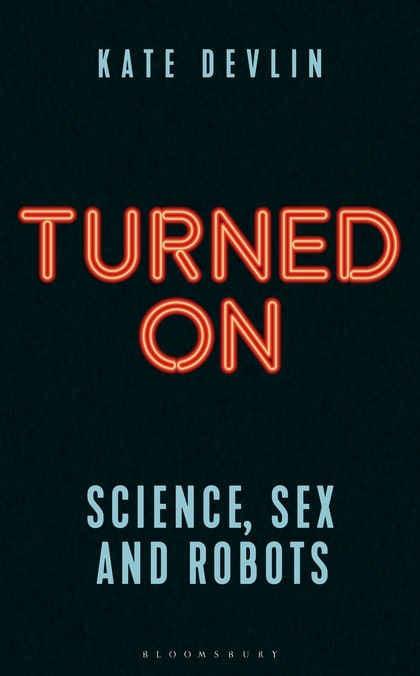When it comes to science fiction and talks of possible technological developments, there are few concepts more prevalent than robots. In order to find a more widely discussed topic, you’d have to turn to sex.
But what of a mixture of the two? Sex and (or even with) robots, oh my!
It’s this intersection of the sensual and the mechanical that computer scientist Kate Devlin analyzes in her book Turned On: Science, Sex and Robots. Turned On consists of 10 chapters critically analyzing philosophical questions regarding human-robot relations, as well as the state of sex robot technology today.
It’s a deep dive into both the possibilities of humans interacting with their creations (in ways that would leave many skeptical, and even outraged) and what can currently only be imagined. This book certainly has an attention-grabbing premise, but is it good?
In order to confront questions of human-robot sexual relations, one must first analyze the meaning of the term “robot,” as well as how humans interact with technology in general. Devlin addresses these matters satisfactorily, with historical and mythological context that may leave many readers shocked by just how long robots have existed.
From the first appearance of what we would now consider a robot in Greek myth to robotic developments in the European medieval period, Devlin dives deep to show that interactions between man and machine are far from a contemporary invention. She does so smoothly, providing the reader with important historical context without ever using the inaccessible language or dull cadence found in the worst of academic writing. Turned On keeps learning enjoyable.
Of course, Devlin’s scope extends beyond the distant past and into the modern age of computing. There are ample references to well-known A.I. programs and studies about how humans interact with other creatures and nonliving things. Devlin covers people’s tendencies to impose human characteristics and feelings on both animals and inanimate objects, which is crucial to any potential human-robot relationship. These segments of the book are fascinating from a psychological perspective, as the reader gets some insight into how humans (including themselves) think, in ways they know aren’t logically sound.
Many people think of sex robots as a largely theoretical concept, but Devlin helps ground them in reality by providing information about the current state of the field. As it turns out, there are several different companies currently developing them, and their attempts shed a lot of light on what people desire in their sex robots. From what goes into choosing an appropriate voice for an A.I., to reasons for the gender ratio of sex robots (the vast majority of said robots are modeled after women rather than men), Devlin addresses virtually everything one could want to know about what sex robots are like, as well as many of the explanations behind these qualities.
While the hard historical facts are a lot of fun, so are Devlin’s ventures into philosophy. Maybe I’m biased, but I found Turned On‘s coverage of ethics both enjoyable and well-reasoned. Any debate about the morals of sex between humans and non-humans must tackle questions of consciousness and consent.
Consciousness, of course, is hardly an easy term to define. With that said, the implications of it, or the lack of it, are huge. If you enjoy the sort of mental gymnastics required to attempt defining abstract concepts, then you’ll likely enjoy these segments. There are also brief discussions of how laws are evolving in reaction to new technologies.
One important note about Turned On is that Devlin grounds the content very firmly in the context of her own relationship to it. For the most part this works well; she’s knowledgeable enough about the subject to come across as a fair source, as well as casual enough to make it understandable for novice readers.
With that said, the conversational diction and asides sometimes feel too casual. There are occasional parentheticals which don’t really contribute anything of substance, and there are instances where the prose would have benefited from getting trimmed down a bit. This isn’t a frequent enough concern to dampen the reading experience to an extreme degree, but it’s still worth noting.
Your mileage may vary on how satisfying the book’s conclusion is. By and large, the final chapters address possibilities regarding the future of sex robot technology and its implications, but these sometimes extend beyond the realm of the primary subject matter for disappointingly long periods of time. There’s a fair amount of discussion regarding sex toys and sex technologies that aren’t specifically robots, which are interesting topics in their own right.
They also tie into the book’s ongoing concern with how humans interact with technology. Some of these passages are quite interesting, so the book’s ending isn’t bad by any means, but there’s something fascinating about humans’ relationships with robots (and the ethical and psychological questions they raise) specifically that is more compelling than much of what’s written about other sex technologies.
Overall, Turned On: Science, Sex and Robots is an enjoyable and accessible traverse through the concept of sex robots. Both robots and sex are analyzed in and of themselves, providing solid context for the questions that arise when the two topics collide. From Greek myths to current technology, Devlin covers an impressive amount of ground here.
While there are some occasional cons with the book’s conversational tone and its deviance from the main subject matter, I would still gladly recommend it to anyone interested in robots, human sexuality, or, especially, both.
Join the AIPT Patreon
Want to take our relationship to the next level? Become a patron today to gain access to exclusive perks, such as:
- ❌ Remove all ads on the website
- 💬 Join our Discord community, where we chat about the latest news and releases from everything we cover on AIPT
- 📗 Access to our monthly book club
- 📦 Get a physical trade paperback shipped to you every month
- 💥 And more!













